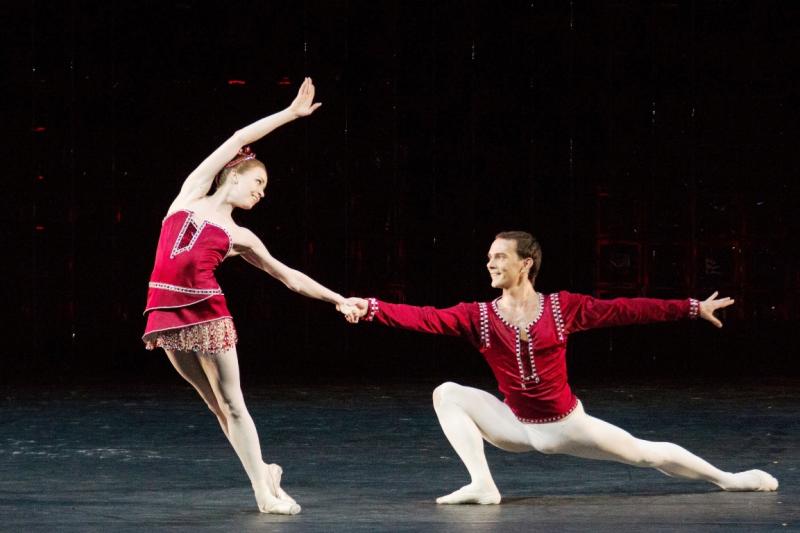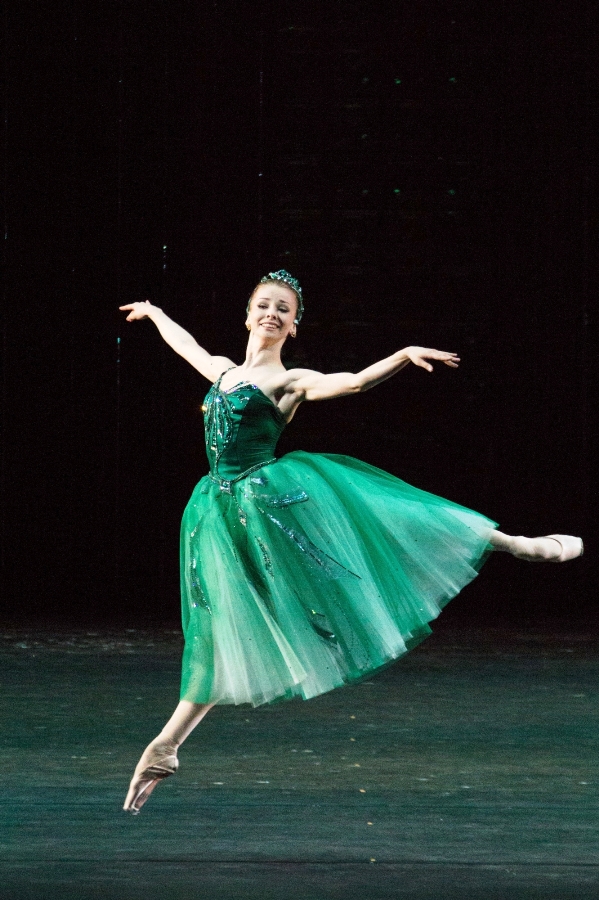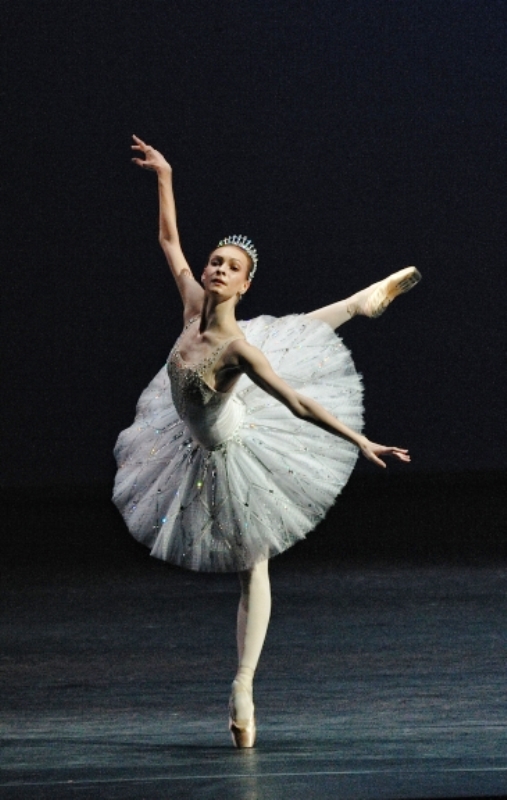Jewels, Bolshoi Ballet, Royal Opera House | reviews, news & interviews
Jewels, Bolshoi Ballet, Royal Opera House
Jewels, Bolshoi Ballet, Royal Opera House
Sergei Filin takes a bow as his company dips a pointe shoe into the 20th century

The Bolshoi’s summer season in London has so far been straight-down-the-line trad: Swan Lake as an opener, Bayadère, Sleeping Beauty. Now, however, with Balanchine’s Jewels, they’ve at least dipped a pointe shoe into the 20th century, if rather cautiously.
Jewels is, to be blunt, a beast of a ballet to get right – or, to change metaphor, it is a will o’ the wisp, ambiguous in style, constantly shape-shifting before our eyes. To get to grips with it, from either side of the footlights, is not simple, and neither the company (who acquired this work only last year) nor the audience was entirely certain of its responses.
 It is a three-act abstract ballet, and a three-act history of dance lesson. Each movement, represented by a jewel, encapsulates a dance style and period. Emeralds, to extracts from Fauré’s Pelléas et Mélisande and Shylock, represents the Romantic movement; Rubies, to Stravinsky’s Capriccio for Piano and Orchestra, neo-classicism; and Diamonds to Tchaikovsky’s Symphony No 3 (minus the first movement) the high classical style.
It is a three-act abstract ballet, and a three-act history of dance lesson. Each movement, represented by a jewel, encapsulates a dance style and period. Emeralds, to extracts from Fauré’s Pelléas et Mélisande and Shylock, represents the Romantic movement; Rubies, to Stravinsky’s Capriccio for Piano and Orchestra, neo-classicism; and Diamonds to Tchaikovsky’s Symphony No 3 (minus the first movement) the high classical style.
Emeralds is the most difficult of the three sections, a gossamer construct of music and mood that disintegrates at the slightest rough handling. And it got a fair amount of that. Evgenia Obraztsova (pictured right), one of their loveliest dancers, danced with restraint and a certain charm, but never found her way into the heart of the style, while Anna Tikhomirova’s dead upper body and flat arms were matched by ears that were seemingly deaf to the music coming out of the pit.
It was left to Ana Turazashvili in the trio to show what could be done. Resembling nothing so much as a Modigliani come to life, Turazashvili floated and drifted, her neck and shoulders always in the correct Romantic shape, even as they were always moving forward, pulsing with Fauré’s phrasing.
Rubies, by contrast, should be bright and brassy and bold, and Ekaterina Krysanova (main picture, above), scampering nimbly through her fiendish solos, her astonishing loose hips allowing her to kick off dazzling développés, did her best to make it just that. Both she and her partner, the careful Dmitri Gudanov, started slowly, but suddenly seemed to realize that if they had fun, we might too; and we did.
Overall, the Bolshoi (like the Royal in this same piece) can’t quite get down and dirty enough – they’re slumming, rather than inhabitants of Stravinsky and Balanchine’s dive. “We’re having fun,” they seem to be saying, “but don’t tell mother.”
Stylistically, altogether the company is a bit lacklustre at the moment. There are too many awkwardly held heads and too many necks pushed down into shoulders when a difficult step approaches, while the men’s arms en couronne look as though someone shouted "stick ’em up!"
 The highlight of the evening was, theoretically, the Bolshoi’s new star, Olga Smirnova (pictured left), who has been dazzling audiences all season, in the final movement, Diamonds. I hadn’t seen Smirnova since she appeared in London a couple of years ago, still a student. She was promising then, triumphant now. But – a big but – Diamonds doesn’t call for triumphalism.
The highlight of the evening was, theoretically, the Bolshoi’s new star, Olga Smirnova (pictured left), who has been dazzling audiences all season, in the final movement, Diamonds. I hadn’t seen Smirnova since she appeared in London a couple of years ago, still a student. She was promising then, triumphant now. But – a big but – Diamonds doesn’t call for triumphalism.
It is perhaps unfair to list the roll-call of greats who have dazzled in Diamonds – Lopatkina, a shining mystery; Farrell, an Amazonian huntress; Cojocaru, a flickering Aurora. Alyona Pikalova's sets remind us that Diamonds is separated from the other two Jewels, which have ballroom surrounds, while Diamonds opens on a night sky. It is mystery and awe that Balanchine hears in Tchaikovsky, and that is explored by the greatest interpreters.
Smirnova is grand rather than mysterious. And her decision to go for a hard, flat brilliance leaves no space for the final most delicate moment in the piece, the supported promenade on pointe, when the ballerina reaches, finally, outwardly to – what? That undiscovered country from whose bourne no traveller returns: death.
In Smirnova’s interpretation, all I could see was courtly demeanour. Her dancing was brilliant and dazzling and amazing. And it was, for me, all wrong.
By far the most moving moment of the evening was not danced at all. With the final curtain calls, Sergei Filin, the company’s artistic director, who was blinded in an acid attack eight months ago and has been having treatment to try and save some small remnant of his sight ever since, appeared on stage. His low bow to the company, many of whom have indicated support for a dancer who may have been involved in the attack, was heartbreakingly generous.
Overleaf: watch Suzanne Farrell and Peter Martins in Jewels
Share this article
Add comment
The future of Arts Journalism
You can stop theartsdesk.com closing!
We urgently need financing to survive. Our fundraising drive has thus far raised £49,000 but we need to reach £100,000 or we will be forced to close. Please contribute here: https://gofund.me/c3f6033d
And if you can forward this information to anyone who might assist, we’d be grateful.

Subscribe to theartsdesk.com
Thank you for continuing to read our work on theartsdesk.com. For unlimited access to every article in its entirety, including our archive of more than 15,000 pieces, we're asking for £5 per month or £40 per year. We feel it's a very good deal, and hope you do too.
To take a subscription now simply click here.
And if you're looking for that extra gift for a friend or family member, why not treat them to a theartsdesk.com gift subscription?
more Dance
 'We are bowled over!' Thank you for your messages of love and support
Much-appreciated words of commendation from readers and the cultural community
'We are bowled over!' Thank you for your messages of love and support
Much-appreciated words of commendation from readers and the cultural community
 Peaky Blinders: The Redemption of Thomas Shelby, Rambert, Sadler's Wells review - exciting dancing, if you can see it
Six TV series reduced to 100 minutes' dance time doesn't quite compute
Peaky Blinders: The Redemption of Thomas Shelby, Rambert, Sadler's Wells review - exciting dancing, if you can see it
Six TV series reduced to 100 minutes' dance time doesn't quite compute
 Giselle, National Ballet of Japan review - return of a classic, refreshed and impeccably danced
First visit by Miyako Yoshida's company leaves you wanting more
Giselle, National Ballet of Japan review - return of a classic, refreshed and impeccably danced
First visit by Miyako Yoshida's company leaves you wanting more
 Quadrophenia, Sadler's Wells review - missed opportunity to give new stage life to a Who classic
The brilliant cast need a tighter score and a stronger narrative
Quadrophenia, Sadler's Wells review - missed opportunity to give new stage life to a Who classic
The brilliant cast need a tighter score and a stronger narrative
 The Midnight Bell, Sadler's Wells review - a first reprise for one of Matthew Bourne's most compelling shows to date
The after-hours lives of the sad and lonely are drawn with compassion, originality and skill
The Midnight Bell, Sadler's Wells review - a first reprise for one of Matthew Bourne's most compelling shows to date
The after-hours lives of the sad and lonely are drawn with compassion, originality and skill
 Ballet to Broadway: Wheeldon Works, Royal Ballet review - the impressive range and reach of Christopher Wheeldon's craft
The title says it: as dancemaker, as creative magnet, the man clearly works his socks off
Ballet to Broadway: Wheeldon Works, Royal Ballet review - the impressive range and reach of Christopher Wheeldon's craft
The title says it: as dancemaker, as creative magnet, the man clearly works his socks off
 The Forsythe Programme, English National Ballet review - brains, beauty and bravura
Once again the veteran choreographer and maverick William Forsythe raises ENB's game
The Forsythe Programme, English National Ballet review - brains, beauty and bravura
Once again the veteran choreographer and maverick William Forsythe raises ENB's game
 Sad Book, Hackney Empire review - What we feel, what we show, and the many ways we deal with sadness
A book about navigating grief feeds into unusual and compelling dance theatre
Sad Book, Hackney Empire review - What we feel, what we show, and the many ways we deal with sadness
A book about navigating grief feeds into unusual and compelling dance theatre
 Balanchine: Three Signature Works, Royal Ballet review - exuberant, joyful, exhilarating
A triumphant triple bill
Balanchine: Three Signature Works, Royal Ballet review - exuberant, joyful, exhilarating
A triumphant triple bill
 Romeo and Juliet, Royal Ballet review - Shakespeare without the words, with music to die for
Kenneth MacMillan's first and best-loved masterpiece turns 60
Romeo and Juliet, Royal Ballet review - Shakespeare without the words, with music to die for
Kenneth MacMillan's first and best-loved masterpiece turns 60
 Help to give theartsdesk a future!
Support our GoFundMe appeal
Help to give theartsdesk a future!
Support our GoFundMe appeal

Comments
It's actuallu Ekaterina
Judith, To comment you last